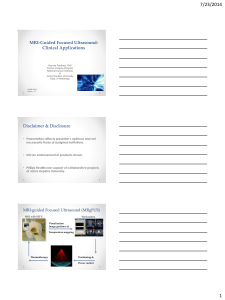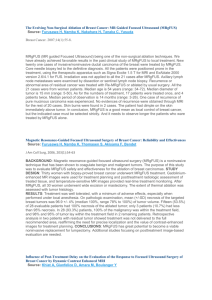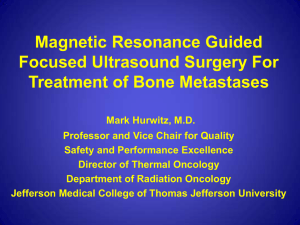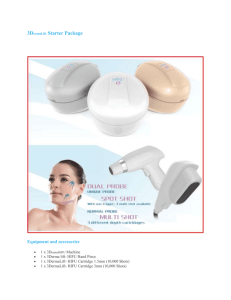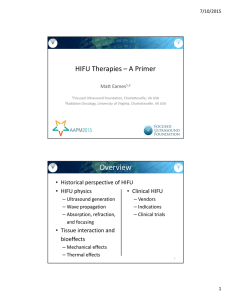The Role of MRI-Guided High-Intensity Focused Ultrasound (MRgFUS) in Cancer Therapy
advertisement
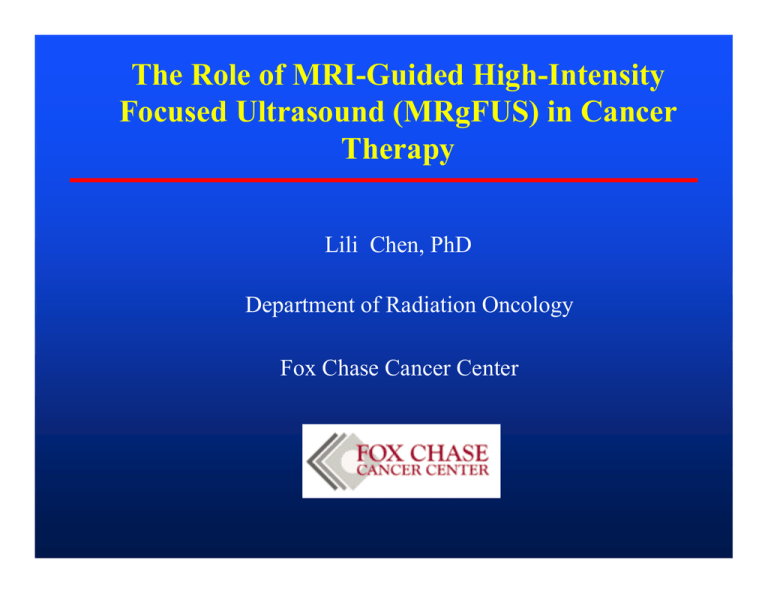
The Role of MRI-Guided High-Intensity Focused Ultrasound (MRgFUS) in Cancer Therapy Lili Chen, PhD Department of Radiation Oncology Fox Chase Cancer Center Outline • Background of MR Guided High-Intensity Focused Ultrasound (MRgFUS) • Currently available MRgFUS systems • The potential of MRgFUS for cancer research and clinical applications Diagnostic Ultrasound Vs Therapeutic Ultrasound Frequency Diagnostic: 3-10 MHz (> 20MHz for skin scan) HIFU: 1-2 MHz Power output Diagnostic: < 5mW/cm2 HIFU: > 100 W/cm2 Background of MRgFUS • High Intensity Focused Ultrasound (HIFU) first investigated in 1942 (Lynn JG et al, biology. J Gen Physiol 1942;26:179-93) Many studies performed by groups of Dr ter Haar & of Dr Hynynen over the 3 decades • Ultrasonic lesions seen on MR first reported in 1993 (Cline HE et al MRM 1993;30:98-106) Schematic Diagram HIFU lesions tissue water tank transducer Focal length Focal region: 3x15 mm Defined on a beam profile (FWHM) The water must be degassed Mechanisms of Tissue Damage • Primary mechanism of damage is thermal, i.e. “cooking” of the tissues (measured temperature >56 ºC at focal zone) • Another mechanism is cavitation Advantages of the MRgFUS • Completely non-invasive therapy • Re-treatment possible • Alternative therapy after RT and surgery HIFU Lesions Histology Findings in Liver (2 h after FUS) treated untreated Factors affecting lesion formation • Intensity • Sonication duration • Lesion separation • Blood flow Effect of Lesion Separation Lesions produced in the liver with 261 W/cm2, 3 mm focal depth, and 5 S exposure duration a) 1 mm exposure separation b) 2 mm separation c) 3 mm exposure separation. Chen et al 1997 UMB Effect of Blood Flow with reduced blood flow with normal blood flow Chen et al 1993 UMB HIFU Surgery under MR Guidance Lesions made in a rabbit brain (in vivo) Chen et al 1999 JMRI How to image HIFU lesions using MR? • T2 shows cell death zone but not for real time monitoring due to time delay Chen et al JMRI 10: 146-153 1999 How to image FUS lesions using MR? • Real-time MR thermometry can provide an indication of tissue damage if temperature thresholds/ thermal Dose are known Graham, Chen and Leitch et al 1999 MRM Temperature Measurement on MRI using Proton Resonant Frequency Shift Method ∆T= Φ - Φo γ α B TE Φo = the initial phase before heating γ = the gyromagnetic ratio α = the coefficient of temperature change 0.01 ppm/ °C for aqueous tissues B = the magnetic field strength TE = the echo time Temperature Maps • In vivo laser ablation • Color overlay where temp > 47°C Courtesy of Dr. K Butts Thermal Dose Calculation (t43 = equivalent time at 43°) C= 0.5 C= 0.25 for >43 ºC for < 43 ºC non-linear behavior for tissue damage: at 43 ºC: 240 min; at 54 ºC: 3s; at 57 ºC: 1s; Sapareto SA and Dewey WC. Int.J.Radiat.Oncol Biol Phys 1984:10:787-800 FUS Equipments Courtesy of Dr. J-F Aubry Oxford, UK & Chongqing, China > 20,000 patients treated in China ExAblate® 2000 Device (InSightec) approved by FDA for treatment of uterine fibroids ExAblate Main Components Operator Console (operator room) Equipment Cabinet (equipment room) Patient Table (scanner room) Patient Table: Patient Cradle The phased array transducer is housed in a sealed bath and connected to a motion system. Transducer Motion system What is MRgFUS? 3D anatomic information for exact tumor targeting Coronal Beam path visualization for safe treatment Real time MR thermometry to achieve planned outcome Axial Sagittal = close loop therapy Correlation of MR Thermometry and Tissue Damage 1 Temperature rise at center of sonication spot 1 3 2 Temperature map of a sonication 2 Temperature rise at margin 3 Temperature rise in untreated area, 7mm from center 1 3 2 Thermal dose threshold (above 240 minutes at 43° C) 1 3 2 Pathology of same sonication Potential Applications for Cancer Treatment • • • • • • Brain tumor Breast cancer Bone metastases (palliative pain relieve) GI ( liver, pancreas) Prostate cancer, Kidney GYN Breast cancer - excisionless study • Objectives: Evaluate long term local recurrence of up to 1.5 cm MRgFUS treated breast carcinoma and evaluate safety of the procedure • Design: Only patients with MR identified single focal lesion (up to 1.5 cm) of T1/T2, N0, M0 disease will be treated • Location: Breastopia Namba Hospital, Miyazaki, Japan Pre treatment T1w+CE MIP image 2 weeks post treatment T1w CE MIP image Breast Cancer: before and after MRgFUS treatment Furusawa et al J Am Coll Surg 203: 54-63; 2006 Brain Tumor Study Objective: • Safely treat brain tumors through intact skull Results: • 3 patients treated (recurrent glioblastoma or metastatic cancer) • No skull heating • Reported to FDA; FDA approved continuation based on safety Brain Tumor Study Results (continued): 2 patients are still alive (27 and 30 months later), 3rd patient survived 10 months after treatment (Paper submitted for publication) A Accumulated thermal dose at end of treatment C B Diffusion weighted image immediately post-treatment T1w contrast enhanced image immediately post-treatment Courtesy of Sheba Medical Center, Tel Aviv, Israel Liver Tumor Study Objective: • Demonstrate capability of treating liver tumors safely with respiratory gating Results: • Treatment synchronized with respiration enables consistent target position during sonications for entire procedure Treated dose following FUS treatment shown on T1w MR Contrast enhanced T1w subtraction image showing the lesion. treated • High quality MR thermal imaging untreated Pathology after 4 days Microscopy pathology MRgFUS for Palliation of Bone Metastasis Treatment principles • • Bone heating is used to ablate the adjacent periosteum Palliation achieved by the ablation of the bone periosteum, which is the sensory origin of the pain MRgFUS for Palliation of Bone Metastasis (FCCC’s experience) • metastatic breast cancer • previous radiation to • • • • left shoulder OxyContin 100 mg bid Oxycodone 30 mg q 4 h prn pain; on average, 3 to 4 doses per day Lidoderm 5% patches daily pain 8 of 10 Score Results (from FCCC) 9 8 7 6 5 4 3 2 1 0 Pain Score 0 9 18 27 36 Day 45 54 CT before Tx CT 3 months after Tx David Gianfelice et al Radiology 2008; 249:355–363 Catane et al Ann Oncol 18:163-7; 2007 Liberman et al Ann Surg Oncol 16:140-6; 2009 Prostate Cancer- Endorectal System • Endorectal phased array probe • Steerable beam for Elongated spots focal spot size control (2 x 7mm to 10 x 30mm) for fast treatment and to prevent complications related to nerve bundle Small spots Nerve bundle • Combined pelvic and endorectal imaging coil for high resolution target definition Transducer Steerable beam and spot size control Animal Studies Accumulated thermal dose following FUS treatment shown on T2w MR coronal image • Contrast enhanced T1w subtraction image showing the lesion Macro pathology image following the procedure showing the ablated areas Correlation between thermal dose, non-perfused volume (NPV) and gross pathology Courtesy of Sheba Hospital, Tel-Aviv, Israel MR guided Pulsed FUS for Enhancement of Local Gene/Drug delivery • Enhancement of drug delivery to tumors with MRgFUS demonstrated in animals modes Nelson JL et al Cancer Res 62:7280-7283 (2002) Yuh EL et al Radiology 234(2): 431 – 437 (2005) Hynynen K. Expert Opin Drug Deliv 4(1):27-35, (2007) • Mechanism: non-thermal effect (stable cavitation) → increase vascular, cell membrane permeability → concentrate macromolecular pharmaceutical agents to the treatment target without permanently damaging the tissue • Applications of pulsed HIFU to enhance the delivery for cancer treatment in chemotherapeutic and gene therapy Enhanced Drug Delivery comparison of 3H-Docetaxel between with HIFU treatment and without HIFU treatment cpm /75 m icro gram 1300 1100 900 700 500 300 100 -100 -300 HIFU + i.v i.v only control • Radioactive tritiated docetaxel used to determine the uptake in prostate tumor Chen et al. at FCCC Conclusions • MRgFUS is a noninvasive, alternative therapeutic tool for cancer treatment • Need large volume of published clinical data from multiple centers to support early experience • Technological advances should help overcome some of the comparative limitations
